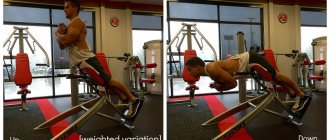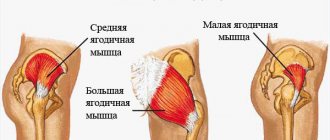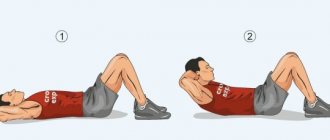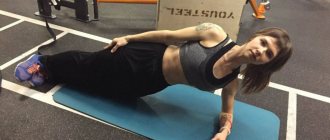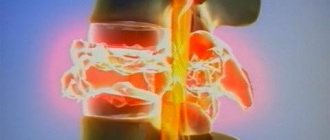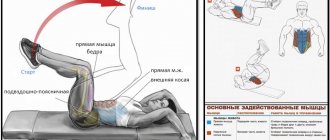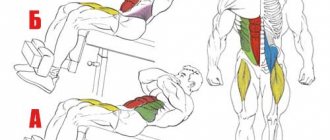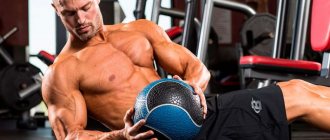Share:
Ab crunches are an exercise performed by athletes to gain strong and sculpted abs. According to its biomechanics, it represents an elevation of the torso with a slight rounding of the back (kyphosis) in the thoracic region from a lying position. As a rule, crunches are not performed by the athlete in the maximum possible amplitude, so that the load is constant and the abdominal muscles do not relax at the top and bottom points. Working in a similar technique, the load is focused on the upper part of the rectus abdominis muscle.
This exercise has gained well-deserved popularity among athletes involved in crossfit, bodybuilding, fitness and martial arts, since a well-developed abdominal press plays an important role in all these disciplines. And today we will tell you how to do crunches correctly - all possible variations of this exercise.
What muscles work during crunches?
During exercises, the entire abs works, but different parts of it are subject to different loads. Depending on what exercise the athlete is doing, one or another part of the abs is worked out with greater or less intensity. Therefore, in order for the entire muscle to develop evenly and quickly, it is necessary to train it using different techniques.
Active muscles during a crunch exercise
Depending on the twist option, the rectus, oblique or transverse abdominal muscles are worked. In addition, in some exercises the hips, arms, shoulders, etc. are involved in the work. Despite this, it is the abdominal muscles that are pumped best, since crunches are aimed at ensuring that the abs are 100% involved in the work. The participation of all other muscles should be minimal.
Contraindications
Most twisting techniques are safe. But there are still medical restrictions to this exercise:
- intervertebral and abdominal hernia;
- untreated musculoskeletal injuries;
- adhesive disease;
- recovery period after major operations;
- rheumatism;
- diseases associated with increased intra-abdominal pressure.
If you have the listed diseases, you can perform crunches only with the permission of a doctor. Don't ignore a visit to a specialist. Otherwise, you may harm yourself.
Successful and safe training!
Twisting technique
In order for the exercises performed to produce results, and the spent energy not to fly into the air, it is necessary to follow the correct technique. In addition, with high-quality performance of all movements, the risk of injury is significantly reduced. Otherwise, the athlete may take a long unplanned break between workouts.
Straight crunches
This type of twisting is considered the easiest, so it is recommended to be done primarily by beginners.
Take starting position:
- Lie down on the floor.
- Press your lower back to the floor surface.
- Bend your knees so that a right angle is formed between your shin and thigh, and place your feet on the floor.
- Choose one of the options for hand position (extend in front of you, fold on your chest or place on the back of your head).
- Next, you need to raise your torso, tensing your abdominal muscles. Only the shoulders lift off the surface of the floor; the lower back remains pressed against it.
Adviсe:
- The distance between the chest and chin should be such that a fist can fit between them. You can't press your chin to your chest.
- When lifting, the back is rounded, rather than the entire torso rising.
- The feet stand firmly on the floor and do not come off.
- At the highest point, you need to pause for a second and inhale as you lower down. The muscles remain tense.
- Without allowing the press to relax, twisting is repeated in a similar way.
- The required number of twists is performed.
Other exercise variations
The abs are a group of muscles. Therefore, for effective training, various loads are required. We offer the most effective twisting options.
Reverse
- Lower your back to the floor. Stretch your arms along your body. Palms face down.
- Bring your feet together and lift your hips vertically. Bend your knee joints at a right angle. Fix your legs in this suspended position.
- With your palms on the floor, exhale and lift your pelvis, pulling your knees toward your chest.
- As you inhale, lower your lower back to the floor.
Lifting the legs should be done by contracting the abs, not tensing the quadriceps.
Lateral
- Press your back to the floor. Bring your legs together and bend them. Move your knees to the right and press them to the floor. The angle between the hips and the body should be straight. The angle at the knees must also be kept at 90°.
- Press your right palm onto your knees, and press your left palm to the back of your head. Lower your shoulder blades to the floor.
- Exhale and twist your upper torso to the right, extending your left elbow at an upward angle.
- As you inhale, lower yourself to the starting position.
The exercise is performed in both directions. When twisting, press firmly with your free hand on the knee joints, this will create additional stretch in the oblique muscles.
With your feet up
- Lie down on the floor and press your lower back. Clasp your fingers at the back of your head.
- Close your feet and lift your legs vertically. The angle between the thigh and body should be straight. For comfort, you can slightly bend your knees.
- Keeping your legs still, exhale and lift your upper torso. Lift by contracting the abdominal muscles.
- As you inhale, move your shoulder blades down, but do not lower them to the floor.
If you want to make the exercise more difficult, change the angle of your legs from 90° to 70–80°.
Diagonal
- Lie on your back and press your lower back into the floor. Place your palms on the back of your head, clasping your fingers.
- Raise your legs above the floor.
- Exhale powerfully and twist your shoulder girdle to the right. At the same time, pull your right knee towards you.
- Repeat twisting to the left.
Keep your abdominal muscles tense throughout the entire approach.
Double
- Lie on your back, clasp your palms at the back of your head.
- Raise your legs vertically and bend your knees at an angle of 90°.
- Exhale while simultaneously pulling your hips toward you and lifting your shoulder blades.
- Inhale and return to the starting position, but do not place your shoulder blades on the floor.
When your face and knees are close to each other, tighten your abdominal muscles as much as possible.
On an incline bench
The bench is used to create an incline and increase the load. As a rule, crunches on a bench are performed using classical and reverse techniques (described above). The only difference is that you should firmly grasp the edge of the seat with your hands to maintain balance.
Choose the angle of inclination yourself. For beginners, we recommend starting with an angle of 15–20°. All other biomechanics of movements are identical to standard crunches on the floor.
On a Roman chair
A special chair is used that fixes the legs in a stationary position. The upper body is suspended. From this position, the athlete curls his upper torso toward his knees and tightens his abdominal muscles.
The position of the arms is any: behind the head, extended forward, crossed on the chest. To increase the load, you can use additional weight (a barbell, dumbbell or other weight) held against the pectoral muscles or behind the neck.
Kneeling in a pulley machine
- Hook the rope handle to the top cable.
- Turn your back to the block, take a short step forward and drop to your knees.
- Press the ends of the handle against the trapezius muscle of the back.
- Exhale and gently twist your upper body toward your knees.
- As you inhale, gently raise your shoulder girdle.
When performing, do not allow jerky movements.
Standing in a pulley machine
- Attach a rope handle to the lower cable, pull it up and turn your back to the block.
- Straighten up and place your feet shoulder-width apart.
- Throw the ends of the handle over your shoulder.
- Exhale and twist your torso towards the opposite leg.
- As you inhale, straighten up.
Twist your entire torso to the side, not just your shoulder girdle.
On a fitness ball
- Press your upper back into the ball. Place your feet firmly on the floor and lift your pelvis.
- Spread your knees shoulder-width apart, clasp your palms behind your head.
- Keeping your pelvic region motionless and suspended, perform forward twists. Do not lower your shoulder blades onto the fitball at the lowest point.
The exercise is also suitable for working the oblique muscles. To do this, twist the shoulder girdle to the sides.
Russians
- Sit on the floor, on your buttocks. Bend your legs and lock your feet in one position, placing them under a stable object.
- Lean your body back slightly, creating a V-shaped body position.
- Stretch your arms forward and clasp your hands.
- Keeping your back tilted, exhale and turn your body to the right. Repeat on both sides.
Avoid rounding your back when performing.
In the “hanging on your forearms” position
To perform this, a special simulator is used, which has a soft back and hand rests, and allows you to hang on your forearms.
The athlete rests his elbows on soft pillows, firmly clasps the handles with his palms and performs a hang. The spine is pressed tightly against the back of the machine. From this position, the athlete simultaneously pulls his knees to his chest.
Lateral hyperextensions
To perform this, a hyperextension machine is used. The athlete stands sideways in the exercise machine. In this case, the femur rests against the edge of the inclined back, and the legs stand firmly on the platforms. Hands go behind your head. From this position, the athlete performs smooth sideways bends.
To increase the load, it is allowed to use additional weight (barbell plate, small bar, body bar) held on the chest or shoulders.
Advice for newbies! If you want to maximize the use of muscle fibers and enhance the effect of any abdominal exercise, at the extreme point of twisting, strongly tighten your abdominal muscles and hold for 2-3 seconds.
Reverse crunches
Unlike straight crunches, this variation lifts the legs, not the torso.
Execution algorithm:
- We lie down on a bench or on the floor.
- We bend our legs at the knees and raise them. Your shins should be parallel to the floor and your thighs should be perpendicular.
- Hands are placed behind the head or holding the edge of the bench.
- Tightening your abdominal muscles, pull your knees towards your chest. When the legs reach the extreme point, the pelvis should be raised above the bench or floor.
- We pause for a second.
- Lower your legs and repeat the twist the required number of times.
When performing the exercise, you need to ensure that your legs are lifted only by the force of your abs. They cannot be extended, as the thigh muscles will also be involved in the work.
How are the abdominal muscles structured?
As a rule, most people’s idea of a beautiful press is limited to “cubes” - that is, the rectus abdominis muscle. Some even divide the press into “upper” and “lower” (which is fundamentally wrong from an anatomical point of view), and then lament that the latter is difficult to train.
- Rectus muscle - it stretches from the ribs to the pubic bone and is a single whole, so under load it works entirely. Across it there are 3-4 tendon bridges that form the well-known “cubes”. There are no bridges closer to the pubic bone and there cannot be “cubes” in this area. The rectus muscle is responsible for tilting the body forward and lifting the pelvis upward
- External oblique muscle - located on both sides of the body and is responsible for its rotation, and also participates in lowering the chest down
- Internal oblique muscle - located directly below the external ones and stretches from the outer part of the inguinal ligament to the ilium. Work when turning the body
- The transverse muscle is the thinnest and deepest muscle. It is located under the internal oblique muscle. Its function is to retract the abdomen and move the ribs towards the midline
Lateral (oblique) twists
This exercise allows you to pump up your oblique muscles well.
Execution order:
- We lie down on the floor, bend our legs and turn to the left.
- We place our right hand behind our head. We place our left hand on the stomach closer to the right side.
- We exhale and, tensing the right oblique muscles, try to reach the right elbow to the right knee.
- At the extreme point, we pause for a second and return to the starting position.
This will work on the right side. Next, you will need to perform similar steps, only on the other side, in order to pump up the left oblique muscles.
Diagonal crunches
This type of exercise is similar to straight crunches, but there are a few differences.
Execution order:
- We lie down on the floor, press our lower back to it, bend our knees to a right angle. You can also sit next to a bed or bench and put your feet on it.
- We place our right hand behind our head, and place our left hand on the floor along the body.
- At the next stage, we lift our shoulder off the floor and try to touch our left knee with our right elbow.
- After contact we return to the starting position.
After this, we perform a similar exercise, working the other side. It is necessary to remember that it is necessary to rise, straining the muscles, while exhaling, and to lower, on the contrary, while inhaling.
Double crunches
The advantage of this exercise over straight crunches is that here the load is evenly distributed throughout the entire abs. As a result, the lower and upper parts of the muscle are well worked out.
Execution order:
- We lie on our backs, press our lower back to the surface of the floor, bend our knees to a right angle, and place our feet on the floor.
- We place our hands behind our heads, but do not cross our fingers.
- As you exhale, pull your chest and pelvis towards each other.
- At the extreme point, we pause for a second and while inhaling we lower ourselves, without lowering our shoulders to the floor.
Do not pull your head with your hands while doing the exercise. This can cause injury to the cervical spine. The load on the press is also reduced.
Abs training programs
Abdominal training should be performed at intervals of at least 48 hours - this is necessary for proper muscle relaxation. The first classes should include no more than three varieties of crunches.
For example:
- Classic crunches – 10 times, 3 sets
- Reverses – 10 times, 3 approaches
- Lateral – 10 times, 3 repetitions for each side
The interval between exercises is 1-2 minutes. After each session you should feel soreness and burning in your muscles. When these sensations disappear, the complex can be complicated by adding new exercises to it, as well as using weights and exercise machines.
Incline crunches
This exercise pumps up the abdominal muscles well, but in addition, the rectus femoris muscles also lend themselves to stress.
Execution order:
- We adjust the inclination of the bench so that the angle is from 30 to 50 degrees. The load level will depend on this.
- We sit on the exercise machine, secure our legs under the bolsters, and fold our arms across our chests.
- We lie down on the bench, lowering ourselves back.
- We take a deep breath, tense our abs and begin to lift our torso. The head and shoulders rise first, and then the torso.
- When the angle between the hips and the torso is 90 degrees, we stop the lift. This will be the highest point.
- We pause for a second and tense our abdominal muscles.
- Slowly lower your torso until it is parallel to the floor. This will be the lowest point.
You should not completely lower yourself onto the bench until the end of the set. It is necessary that the abdominal muscles are in constant tension.
Standing cable crunches
Crunches performed using a block simulator work well on the upper and internal muscle groups. At the same time, the exercise is completely safe for the lumbar region.
The exercise is performed according to the following algorithm:
- We fix the rope handle on the simulator.
- We set the required weight.
- We stand with our back to the projectile and pull the handle to the top of our chest.
- Exhale and bend your back, trying to pull the handle lower.
- We inhale and return to the starting position.
Crunches on a block machine while standing on your knees
With this exercise you will draw the upper cubes and obliques.
Execution order:
- We set the required weight.
- We stand facing the machine and take the handle so that our palms are turned inward.
- We take two steps back and kneel down.
- We tilt our torso down so that it is almost parallel to the floor.
- Raise your arms above your head so that the angle at your elbows becomes straight.
- We bend a little at the lower back and, as we exhale, lower our torso to the floor.
- At the bottom point, we try to tense our abs strongly and hold for a second.
- We go back and repeat the twisting the required number of times.
Crunches on a fitball
This type of crunch is more suitable for athletes with average training.
The exercise is performed in this order:
- We sit on the fitball and spread our legs to the sides.
- We roll down a little so that our back rests on the ball.
- We put our hands behind our heads.
- As you exhale, perform a twist, lifting your torso up.
- We pause for a second and tense our abdominal muscles.
- Let's go back.
During twisting, it is necessary to constantly keep the press under load. You also need to bend your back so that your abdominal muscles tighten as much as possible.
Read also[edit | edit code]
- Press exercises and training features
- Abdominal exercises for girls
- Forward Bend Twist
- Crunches in the simulator
- Crunches on a fitball
- Twisting with body rotation
- Twisting with body rotation
- Twisting with body lift on an incline bench
- Raising the body from a lying position
- Double twist
- Two-stage twisting
- Diagonal twist
- Straight twist
- Combined twist
- Side crunches
- Reverse crunch on the ball
Roman chair crunches
Not every gym has a Roman chair, so if an athlete manages to find this machine, then he can be considered lucky.
Exercise technique:
- We sit on the simulator. The buttocks should not protrude beyond the edges of the seat. We fold our arms over our chests and place our legs behind the support.
- We take a breath and lower ourselves back. We stop when the torso is slightly higher than the hips.
- From the lowest point we do a twist. When the most difficult section of the amplitude is passed, we exhale and stop. We pause for a second and lower ourselves.
- We do the required number of repetitions.
- Don't go too low while doing crunches. This can injure your lower back.
Typical beginner mistakes
Many abdominal exercises have their own technical nuances that you need to master in order to get the most out of them. Let's look at the most common mistakes, myths and misconceptions:
- You should not train your abs more than 1-2 times a week. Crunches are a fairly easy exercise, but even after it the body needs time to recover.
- By performing a large number of repetitions, you will not burn excess fat deposits on your stomach and get the coveted “cubes”. The optimal repetition range for crunches is 12-20; in combination with a diet tailored to your goals, this approach will give maximum results.
- Do not use too heavy a weight. If you do crunches with a disc or dumbbell, do not chase the weights, it is better to focus on mental concentration and contract the abdominal muscles more isolated, but involving no assistant muscles in the work.
Recipes for healthy eating
Cannelloni with ricotta and spinach
- 9.9 g Protein
- 5.3 g Fat
- 12.1 g Carbohydrates
- 141.2 kcal
40-50 min.
- #second course
- #dietary
- #baking
- #cream cheese
- #low calorie
- #dinner
- #vegetable oil
- #sour cream
- #spices
- #dinner
- #spinach
Other recipes
Russian crunches
Using this version of the exercise, you can draw out the oblique abdominal muscles, achieve a flat stomach, and reduce the volume of the abdominal cavity.
Classically, the option is performed in this order:
- We sit on the floor, bend our knees and lean back a little.
- We lift our feet off the floor.
- We turn the body in one direction or the other. The legs remain motionless.
- Perform the required number of repetitions.
The benefits of crunches
The benefits of crunches for the abdominal muscles cannot be disputed. When performing a set of exercises, you can achieve stunning results. The main thing is to follow the correct techniques.
These exercises also have benefits for the spine. When performing various types of twists, its flexibility improves, and as a result, its general condition. Blood flow increases, which delivers beneficial nutrients to the spinal discs.
Such exercises strengthen the tissues and prepare them for heavy loads. As a result, the risk of future injury is significantly reduced.
In addition, blood flow to internal organs improves, the functioning of the digestive system is stabilized, and memory improves.
Also, a strong abs keeps the spine healthy, because the stronger the muscle corset, the less stress the skeleton receives.
Nutrition for beautiful abs
“I have abs, but they are not visible under a layer of fat” - Have you ever heard such a statement from self-critical people? But, like every joke, there is some truth in it: if a person is overweight, crunches alone will not be enough to burn fat and give the stomach definition.
The so-called “body drying” is popular among athletes - a diet in which carbohydrates are almost completely excluded from the diet, and preference is given to protein foods. It allows you not only to quickly lose weight, but also to lose excess water, as a result of which the body becomes toned and muscle definition is drawn.
It is not necessary to resort to such extreme measures; it is enough to exclude foods rich in carbohydrates and fats from the diet and consume more protein - that is, protein found in lean meat, fish, eggs, legumes, as well as in dairy and seafood.
The one who walks can conquer the mountain!
Crunches bring great benefits not only to the muscles, but to the entire body. For a beginning athlete, the main thing is to figure out whether he can do such exercises before going to the gym or exercising at home. In the presence of dangerous diseases, an innocent desire to get in good shape can end very badly.
Don’t forget that abdominal exercises alone won’t do it. To avoid imbalance, it is necessary to work out other muscle groups. First of all, together with the abdominal muscles, you need to pump your back so that your torso develops harmoniously.
All types of twisting must be done smoothly and without jerking, tensing the abs as much as possible. Only in this case will you soon be able to see the result.
